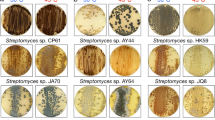Abstract
Temperatures in excess of 45°C are required to stop the growth ofSchizophyllum commune colonies. Transfer of colonies from normal growth conditions (21°C) to 55°C, while halting mycelial expansion and increasing the production of aerial hyphae, was not lethal. Shortterm heat shock (3h) resulted in the appearance of nine proteins resolvable by SDS-PAGE that were newly synthesized or had their synthesis increased. The molecular weights of these proteins qualify two of them as being members of the hsp90 and hsp 70 families of heat shock proteins. Heat shock also affected proteolytic processes in the colonies. Changes in the pattern of ubiquitinated protein conjugates occurred; fewer high-molecular-weight conjugates were found in heat-shocked colonies, and the appearance of a ladder of lower-molecular-weight conjugates was noted. Protease enzymes detected by gelatin-gel PAGE showed a general decrease in activity. One of these proteases, which was up-regulated during nitrogen deprivation, showed an intermediate response during the combined stresses of heat shock and nitrogen starvation.
Similar content being viewed by others
Literature Cited
Anderson M, Deppe C (1976) Control of fungal development. I. The effects of two regulatory genes on growth inSchizophyllum commune. Dev Biol 53:21–29
Bradford M (1976) A rapid and sensitive method for the quantification of microgram quantities of protein utilizing the principle of protein-dye binding. Anal Biochem 72:248–254
Chiang HL, Terlecky SR, Plant CP, Dice JF (1989) A role for a 70-kilodalton heat shock protein in lysosomal degradation of intracellular proteins. Science 246:382–385
Dice JF, Chiang HL (1989) Peptide signals for protein degradation within lysosomes. Biochem Soc Symp 55:45–55
Finley D, Chau V (1991) Ubiquitination. Annu Rev Cell Biol 7:25–69
Goff SA, Voellmy R, Goldberg AL (1988) Protein breakdown and the heat-shock response In: Rechsteiner M (ed) Ubiquitin. New York: Plenum Press, pp 207–238
Hershko A (1988) Ubiquitin-mediated protein degradation. J Biol Chem 263:15237–15240
Holden DW, Kronstad JW, Leong SA (1989) Mutation in a heat-regulated hsp 70 gene ofUstilago maydis. Eur Mol Biol Organ 8:1927–1934
Laemmli U (1970) Cleavage of structural proteins during assembly of the head of bacteriophage T4. Nature 227:680–685.
Lilly WW, Higgins SM, Wallweber GJ (1990) Electrophoretic detection of multiple proteases fromSchizophyllum commune. Mycologia 82:505–508
Lilly WW, Wallweber GJ, Higgins SM (1991) Proteolysis and amino acid recycling during nitrogen deprivation inSchizophyllum commune. Curr Microbiol 23:27–32
Lindquist S (1986) The heat shock response. Annu Rev Biochem 55:1151–1191
Lindquist S, Craig EA (1988) The heat-shock proteins. Annu Rev Genet 22:631–677
Margulis BA, Zhivotovski BD, Pospelova TV, Smagina LV (1991) Patterns of protein synthesis in various cells after extreme heat shock. Exp Cell Res 193:219–222
May GD, Lilly WW (1988) A rapid method for extraction of membrane-plate grown fungal cultures. Mycologia 80:247–249
Neidhardt FC, VanBogelen RA (1987) Heat-shock response. In: Neidhardt FC (ed)Escherichia coli andSalmonella typhimurium. Washington, DC: American Society for Microbiology, pp 1334–1345
Parsell DA, Sanchez Y, Stitzel JD, Lindquist S (1991) Hsp 104 is a highly conserved protein with two essential nucleotide-binding sites. Nature 353:270–273
Plesofsky-Vig N, Brambl R (1985) Heat shock response ofNeurospora crassa: protein synthesis and induced thermotolerance. J Bacteriol 162:1083–1091
Plesofsky-Vig N, Brambl R (1990) Gene sequence and analysis of hsp30, a small heat shock protein ofNeurospora crassa which associates with mitochondria. J Biol Chem 265: 15432–15440
Rechsteiner M (1987) Ubiquitin-mediated pathways for intracellular proteolysis. Annu Rev Cell Biol 3:1–30
Silver JC, Andrews DR, Pekkala D (1983) Effect of heat shock on synthesis and phosphorylation of nuclear and cytoplasmic proteins in the fungusAclya. Can J Biochem Cell Biol 61:447–455
Stephanou G, Demopoulos NA (1986) Heat shock phenomena inAspergillus nidulans. Curr Genet 10:791–796
Terlecky SR, Chiang HL, Olson TS, Dice JF (1992) Protein and peptide binding and stimulation of in vitro lysosomal proteolysis by the 73 kDa heat shock cognate protein. J Biol Chem 267:9202–9209
Towbin H, Staehelin T, Gordon J (1979) Electrophoretic transfer of proteins from polyacrylamide gels to nitrocellulose sheets: procedure and some applications. Proc Natl Acad Sci USA 76:4350–4354
Vierling E (1991) The roles of heat shock proteins in plants. Annu Rev Plant Phys Plant Mol Biol 42:579–620
Welch WJ, Suhan JP (1986) Cellular and biochemical events in mammalian cells during and after recovery from physiological stress. J Cell Biol 103:2035–2052
Wessels JGH, de Vries OMH, Asgeirsdottir SA, Schuren FHJ (1991) Hydrophobin genes involved in formation of aerial hyphae, and fruit bodies inSchizophyllum. Plant Cell 3:793–799
Author information
Authors and Affiliations
Rights and permissions
About this article
Cite this article
Higgins, S.M., Lilly, W.W. Multiple responses to heat stress by the basidiomyceteSchizophyllum commune . Current Microbiology 26, 123–127 (1993). https://doi.org/10.1007/BF01577364
Issue Date:
DOI: https://doi.org/10.1007/BF01577364




